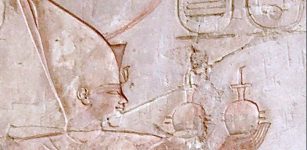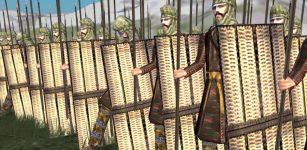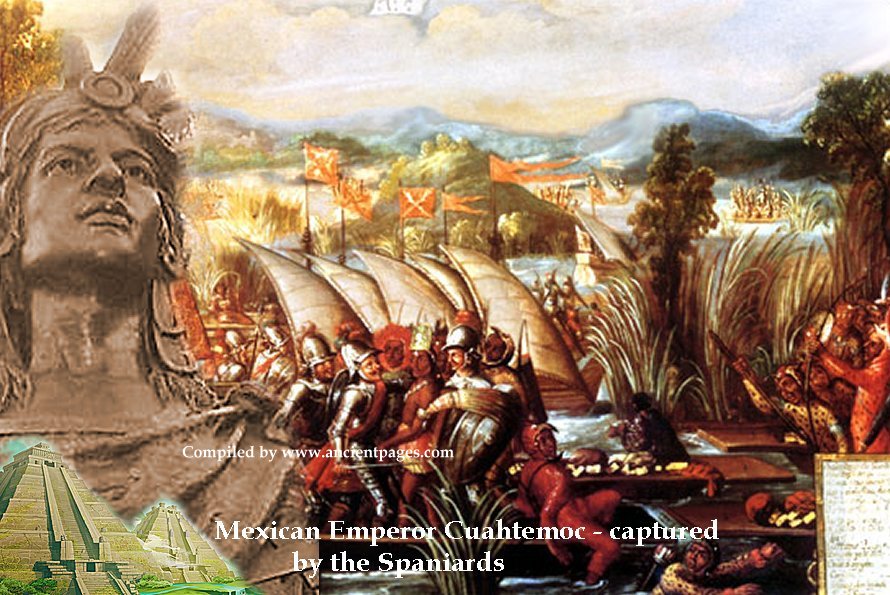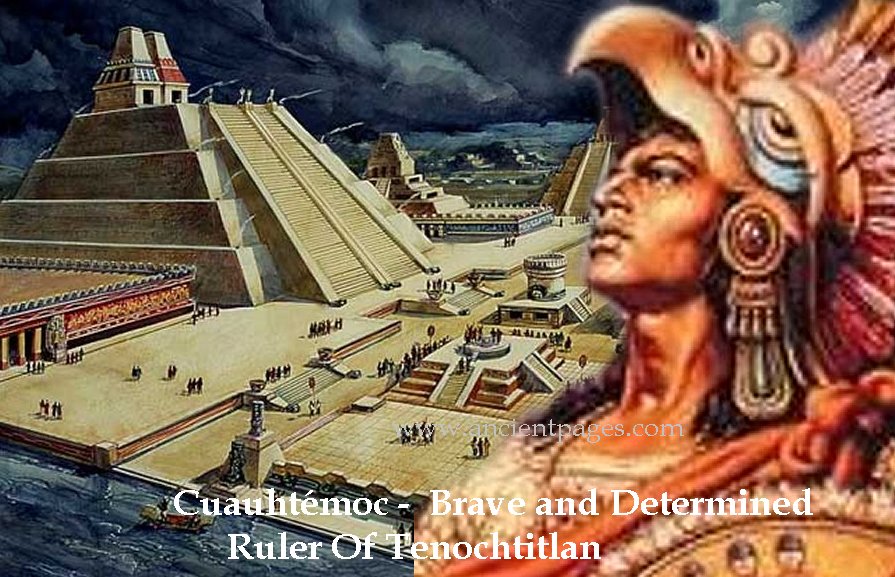Cuauhtémoc: Brave And Determined Ruler Of Tenochtitlan And The Last Aztec Emperor
A. Sutherland - AncientPages.com - Exactly today but 493 years ago, on February 28, 1525, the last ruler of the Aztecs, was executed by the conquistadors of Hernán Cortés.
He was the last tlatoani, which in Nahuatl, means "one who speaks, ruler" and his name Cuauhtemoc means “descending eagle” or “falling eagle”. This name suited tlatoani Cuauhtemoc perfectly. He was a young heroic, aggressive, and determined ruler of Tenochtitlan for a very short time, only from 1520 to 1521.
Cuauhtémoc who was Motecuhzoma II’s nephew was chosen as tlatoani in difficult times, when his predecessor, Cuitláhuac, younger brother of Moctezuma II, died, (probably) due to the smallpox epidemy that lasted for over two months and left thousands dead.
The young man possessed the bravery needed in a leader during this time of crisis. In December 1520, Cortés’ forces and allies began to approach Tenochtitlán, the heart of the Aztec Empire.
See also:
Aztec Empire: ‘Tlatoani’ – The Ruler With The Ultimate Power In The Land
Weapons Of Ancient Aztec Warriors Of Mesoamerica
Why The Aztecs Called Themselves ‘Mexica’
Cortés had a plan; he wanted to set up a siege. Using more than 8,000 native workers, the Spanish had built 12 brigantines (a type of sailing ship) that he planned to use to cross Lake Texcoco, in central Mexico. Taken apart and carried to the lake, the ships were then reassembled. In this military tactic, an army surrounds a city or fort and prevents it from receiving supplies or additional troops. Cortés cut the flow of freshwater into the city because he knew that a city without food and water had no chance to survive.
On May 30, 1521, the Spanish launched the brigantines they had brought in pieces to the shores of Lake Texcoco. They used their ships to attack the Aztecs on the causeways and to stop canoes from crossing the lake to bring supplies.
Cuauhtémoc was aware of the situation.
Along with him, the Aztecs defended themselves heroically, but they were alone because their allies abandoned them at the time.
The Aztecs held out for 80 days. During that time, Cortés and his troops already occupied the southern shore of the island. They fought their way through the city, gradually advancing street by street, but it was not easy as the Aztecs resisted to the very end.
See also: Spanish Conquistadors Led By Hernan Cortés Entered The Aztecs Capital Tenochtitlán – On Nov 8, 1519
Cortés wanted so much to spare the great city of Tenochtitlan for himself, but the Aztecs refused to surrender, so the only way to conquer Tenochtitlan was to destroy it.
The Aztecs' tough leader, Cuauhtémoc, was captured on August 13, 1521, while fleeing Tenochtitlán in disguise with his wife, family, and friends. He surrendered to Hernán Cortés and, according to Spanish sources, he offered Cortés his knife and asked to be killed.
He was tortured to reveal the location of hidden Aztec gold, which probably did not exist. He withstood the torture of having his feet held against fire. Cortés eventually had Cuauhtémoc executed for conspiring against him.
It is still debated whether there actually was a conspiracy or not.
Written by – A. Sutherland AncientPages.com Staff Writer
Copyright © AncientPages.com All rights reserved. This material may not be published, broadcast, rewritten or redistributed in whole or part without the express written permission of AncientPages.com
Expand for referencesReferences:
Smith M. E. The Aztecs
Coe M. D Mexico: From the Olmecs to the Aztecs
More From Ancient Pages
-
 Recently Found ‘Neanderthal Footprints’ In the South Of Spain Could Be 275,000 Years Old
Featured Stories | Dec 1, 2022
Recently Found ‘Neanderthal Footprints’ In the South Of Spain Could Be 275,000 Years Old
Featured Stories | Dec 1, 2022 -
 Remains of Santorini Volcanic Eruption Discovered West Of Suez Canal
Archaeology | Jan 3, 2016
Remains of Santorini Volcanic Eruption Discovered West Of Suez Canal
Archaeology | Jan 3, 2016 -
 Cosmic Rays Reveal Mysterious Void Inside Great Pyramid – What’s Hiding Inside?
Archaeology | Nov 2, 2017
Cosmic Rays Reveal Mysterious Void Inside Great Pyramid – What’s Hiding Inside?
Archaeology | Nov 2, 2017 -
 Paleolithic Inhabitants Of Cyprus Established Settlements Much Earlier Than Previously Estimated
Archaeology | May 17, 2024
Paleolithic Inhabitants Of Cyprus Established Settlements Much Earlier Than Previously Estimated
Archaeology | May 17, 2024 -
 Rock-Hewn Burial Shafts And 38 Symbolic Pots Discovered In Abusir Necropolis, Egypt
Archaeology | Feb 6, 2018
Rock-Hewn Burial Shafts And 38 Symbolic Pots Discovered In Abusir Necropolis, Egypt
Archaeology | Feb 6, 2018 -
 Unique Tomb Of Roman Noblewoman Caecilia Metella Reveals Secrets Of Ancient Concrete Resilience
Archaeology | Oct 14, 2021
Unique Tomb Of Roman Noblewoman Caecilia Metella Reveals Secrets Of Ancient Concrete Resilience
Archaeology | Oct 14, 2021 -
 On This Day In History: Tycho Brahe 1st Sketches “Tychonic System” Of Solar System – On Feb 13, 1578
News | Feb 13, 2017
On This Day In History: Tycho Brahe 1st Sketches “Tychonic System” Of Solar System – On Feb 13, 1578
News | Feb 13, 2017 -
 Mysterious 70-Million-Year-Old Underground Village And Magnificent Tower Of Eben-Ezer In Belgium
Featured Stories | Mar 20, 2017
Mysterious 70-Million-Year-Old Underground Village And Magnificent Tower Of Eben-Ezer In Belgium
Featured Stories | Mar 20, 2017 -
 Ezekiel’s Secret Ancient Knowledge About Lost Worlds – Thought-Provoking Theory Examined
Ancient Mysteries | May 3, 2019
Ezekiel’s Secret Ancient Knowledge About Lost Worlds – Thought-Provoking Theory Examined
Ancient Mysteries | May 3, 2019 -
 Artifacts And Remnants Of 3,000-Year-Old City Unearthed Near Great Zab River In Iraqi Kurdistan
Archaeology | Jun 5, 2017
Artifacts And Remnants Of 3,000-Year-Old City Unearthed Near Great Zab River In Iraqi Kurdistan
Archaeology | Jun 5, 2017 -
 2,500-Year-Old Olmec Related Mexican Cave Paintings Are Now Restored And Protected
Civilizations | Sep 18, 2015
2,500-Year-Old Olmec Related Mexican Cave Paintings Are Now Restored And Protected
Civilizations | Sep 18, 2015 -
 51,000-Year-Old Bone Carving Shows Neanderthals Were Artistic Long Before Humans Arrived
Archaeology | Jul 6, 2021
51,000-Year-Old Bone Carving Shows Neanderthals Were Artistic Long Before Humans Arrived
Archaeology | Jul 6, 2021 -
 Many Samurai Had Swords With Secret Crucifixes And Hidden Christian Symbols To Avoid Persecution
Ancient History Facts | Jan 10, 2017
Many Samurai Had Swords With Secret Crucifixes And Hidden Christian Symbols To Avoid Persecution
Ancient History Facts | Jan 10, 2017 -
 Magnificent Pre-Dynastic City Of Sais And Its Lost Neglected Ruins
Civilizations | Sep 29, 2020
Magnificent Pre-Dynastic City Of Sais And Its Lost Neglected Ruins
Civilizations | Sep 29, 2020 -
 Norman Dominance Of Europe Inspired First Crusades In The Holy Land – New Book Claims
History | Sep 8, 2022
Norman Dominance Of Europe Inspired First Crusades In The Holy Land – New Book Claims
History | Sep 8, 2022 -
 Stunning Underwater Photos Reveal Secrets Of Legendary Lost City Of Heracleion
Featured Stories | May 4, 2013
Stunning Underwater Photos Reveal Secrets Of Legendary Lost City Of Heracleion
Featured Stories | May 4, 2013 -
 Why Was The Face Of Mysterious Ust-Taseyevsky Stone Idol Suddenly Changed?
Archaeology | Jan 18, 2021
Why Was The Face Of Mysterious Ust-Taseyevsky Stone Idol Suddenly Changed?
Archaeology | Jan 18, 2021 -
 Bad King John’s Lost Treasure May Be Hidden Near The Walpole Marsh In The Fenlands – Archaeologists Say
Archaeology | Mar 27, 2024
Bad King John’s Lost Treasure May Be Hidden Near The Walpole Marsh In The Fenlands – Archaeologists Say
Archaeology | Mar 27, 2024 -
 2,000-Year-Old Lavatory In Turkey’s Denizli Province Will Be Restored
Archaeology | Aug 4, 2020
2,000-Year-Old Lavatory In Turkey’s Denizli Province Will Be Restored
Archaeology | Aug 4, 2020 -
 Who Were Persian ‘Sparabara’?
Featured Stories | Aug 28, 2017
Who Were Persian ‘Sparabara’?
Featured Stories | Aug 28, 2017


